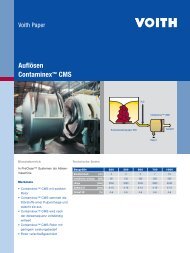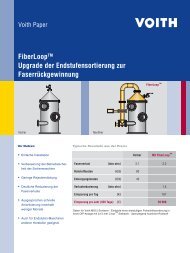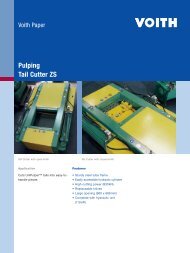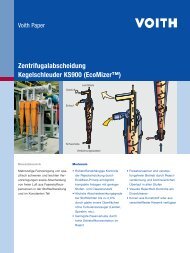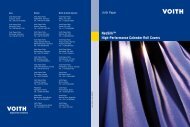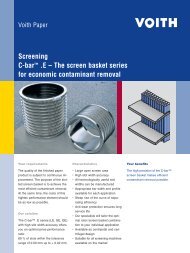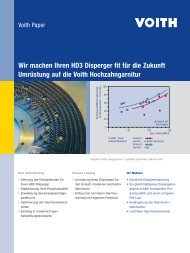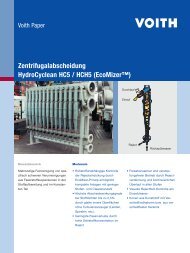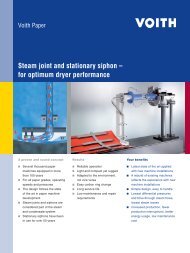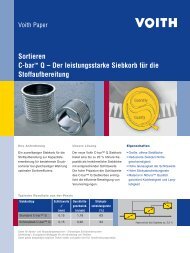Profilmatic Advanced profile control strategies - Voith
Profilmatic Advanced profile control strategies - Voith
Profilmatic Advanced profile control strategies - Voith
You also want an ePaper? Increase the reach of your titles
YUMPU automatically turns print PDFs into web optimized ePapers that Google loves.
<strong>Voith</strong> Paper GmbH & Co. KGHeidenheim, GermanyTel. +49 7321 37-2752<strong>Voith</strong> Paper TechnologyRussia GmbHSt. Petersburg, Russia<strong>Voith</strong> Paper Fiber SystemsGmbH & Co. KGRavensburg, Germany<strong>Voith</strong> PaperTel. +7 812 325-8203Tel. +49 751 83-01<strong>Voith</strong> Paper GmbH & Co. KGRavensburg, Germany<strong>Voith</strong> Paper Inc.<strong>Voith</strong> Paper GmbH & Co. KGTel. +49 751 83-01Appleton (WI), USASt. Pölten, Austria<strong>Voith</strong> Paper OyVantaa, FinlandTel. +358 10 21844-00<strong>Voith</strong> Paper ABDjursholm (Stockholm), SwedenTel. +1 920 731-7724<strong>Voith</strong> Paper Corp.Coquitlam (BC), CanadaTel. +1 604 528-9770<strong>Voith</strong> PaperTel. +43 2742 806-2674<strong>Voith</strong> Paper GmbHKrefeld, GermanyTel. +49 2151 896-0Automation<strong>Profilmatic</strong><strong>Advanced</strong> Cross DirectionProfile Control SoftwareTel. +46 8 62207-40Máquinas e Equipamentos Ltda.São Paulo (SP), Brazil<strong>Voith</strong> Paper Automation<strong>Voith</strong> Paper ASTel. +55 11 3944-4000GmbH & Co. KGLier, NorwayHeidenheim, GermanyTel. +47 3285-9100<strong>Voith</strong> PaperTel. +49 7321 37-6115China Rept. Office Shanghaivoithpaper.automation@voith.com<strong>Voith</strong> Paper B.V.Shanghai, ChinaVaassen, NetherlandsTel. +86 21 520 80388<strong>Voith</strong> Paper AutomationTel. +31 578 579-700GmbH & Co. KG<strong>Voith</strong> Paper Co., Ltd.47803 Krefeld, Germany<strong>Voith</strong> Paper Ltd.Tokyo, JapanTel. +49 2151 896-0Manchester, Great BritainTel. +813 3277-4102Tel. +44 161 643-9273<strong>Voith</strong> Paper Automation<strong>Voith</strong> Paper Technology Ltd.GmbH & Co. KG<strong>Voith</strong> Paper SASCalcutta, India88212 Ravensburg, GermanyOrsay, FranceTel. +91 33 2300-5000Tel. +49 751 83-2991Tel. +33 164865-570PT. <strong>Voith</strong> Paper<strong>Voith</strong> Paper Automation<strong>Voith</strong> Paper S.A.Jakarta, IndonesiaGmbH & Co. KGTolosa (Guipúzcoa), SpainTel. +62 21 7884 59223100 St. Pölten, AustriaTel. +34 943 67-3799Tel. +43 2742 806-2280<strong>Voith</strong> Paper Australia and<strong>Voith</strong> Paper S.r.L.New Zealand Pty. Ltd.<strong>Voith</strong> Paper Automation Japan Ltd.Schio (Vicenza), ItalyNorth Ryde (NSW), AustraliaYokohama 224-0001 JapanTel. +39 0445 690-500Tel. +61 2 9888 9399Tel. +81 45 911-8354<strong>Voith</strong> Paper Automation Inc.PO Box 2337Appleton, WI 549-23337 USATel. +1 920 731 7724info.voithpaper@voith.comwww.voithpaper.comAUT 1006 RS 2005-02 1000
<strong>Profilmatic</strong>For superior <strong>profile</strong> <strong>control</strong> resultsModuleJetModuleStepCD DeviationScanner PathResponseFunctionEdge LogicAutoMappingActuatorSplitting LogicModemSupportCompromiseControl LogicTemp DeviationCD ActuatorsTransport Delay+Scanning TimeProfileMeasurementRawProfilesSPC/SQC LogicControlProfileProfile ControlActuatorSetpointsMD DeviationScannerPaper Direction+/- 1s<strong>Profilmatic</strong> Control SoftwareMeanValueTime<strong>Profilmatic</strong> functional <strong>control</strong> diagram<strong>Profilmatic</strong> StrategiesDistinguishing random noise from true <strong>profile</strong> variationBenefitsStatistical measurement techniques<strong>Profilmatic</strong>® cross direction <strong>control</strong>Continuous dynamic <strong>profile</strong>These new <strong>control</strong> techniques haveUnique, continuous dynamicActuator splitting strategy providesOptional redundant <strong>Profilmatic</strong>software comprises a family ofmapping ensures accurate align-revolutionized the speed andmapping eliminates alignmentoptimum <strong>control</strong> for a single qualitycomputers provide high reliabilityadvanced <strong>control</strong> <strong>strategies</strong> thatment of each actuator against eachperformance of <strong>Profilmatic</strong> <strong>profile</strong>errors for optimum <strong>control</strong>variable using multiple CDand additional incremental results.deliver fast response and flatmeasurement zone. This eliminates<strong>control</strong> and provide the foundationperformance.actuators.<strong>profile</strong>s.the effect of web wander orfor superior <strong>control</strong> results.The redundant computer mirrors thedifferential shrinkage that occurs atAdaptive tuning algorithms provideControl weighting strategy providestuning and setup factors of the<strong>Profilmatic</strong> sets new standardsgrade change or furnish change.<strong>Profilmatic</strong> <strong>control</strong> integrates withflat <strong>profile</strong>s with a fast response,the ability to factor a secondaryprinciple computer.in <strong>profile</strong> quality by employingthe OnQ Quality Control Systemwhile eliminating the need for gradequality variable into a primarystatistical process and qualityControl tuning is simplified withor other compliant QCS measure-grouping the <strong>control</strong> tuningquality variable.<strong>control</strong> (SPC & SQC) techniques.<strong>Profilmatic</strong>ʼs adaptive tuningment platforms to <strong>control</strong> eitherparameters.The <strong>profile</strong> shape is quickly andalgorithms. These help eliminate<strong>Voith</strong>ʼs Module actuators or actua-Fast, aggressive caliper <strong>profile</strong>accurately determined fromthe need for complex grade-tors from third party suppliers.CD <strong>control</strong> modelling techniquesrecovery strategy following breaksunfiltered, high-resolution <strong>profile</strong>dependent tuning.eliminates traditional “saw-tooth”minimizes quality losses.measurements. By distinguishingactuator output array tendencies.random noise from true CD<strong>Profilmatic</strong>ʼs <strong>control</strong> modellingSimple, efficient initial set-up andvariation, it eliminates slowtechniques help avoid “saw-tooth”Configurable set-up options aretuning takes less than one hour.traditional filtering methods of data<strong>control</strong> tendencies, where adjacentincluded for <strong>control</strong>ling actuatorsacquisition.actuator outputs are runningthat are outside the measuredcounter to each other.<strong>profile</strong>.23
<strong>Profilmatic</strong><strong>Advanced</strong> <strong>profile</strong> <strong>control</strong> <strong>strategies</strong>ModuleSteam DirectModuleSprayCD ActuatorsCD ActuatorsCD ActuatorsActuator OutputWeb WanderNon-Linear ShrinkageNon-LinearActuator SpacingExpected ResponseScannerScannerScannerActual ResponseData BoxesMeasurement Mapping ErrorData BoxesEdge Measurement Mapping ErrorData BoxesEdge Measurement Mapping ErrorNew Response ModeMapping errors: actuator position and data box measurement<strong>Profilmatic</strong> dynamic <strong>profile</strong> mappingControl Strategy OverviewFast Profile AcquisitionDynamic Profile MappingElimination of Saw-Tooth EffectsAutomatic Control<strong>Profilmatic</strong> cross direction <strong>control</strong><strong>Profilmatic</strong> CD <strong>control</strong> analyzesA dynamic on-line mappingSaw-toothing can be eliminated in<strong>Profilmatic</strong> <strong>control</strong> recognizes these<strong>Profilmatic</strong> CD Control provides ansoftware combines a family ofunfiltered, high-resolution <strong>profile</strong>algorithm continuously determinestwo ways:patterns and optimizes the outputintegrated automatic tuning functionadvanced <strong>control</strong> <strong>strategies</strong> thatdeliver superior performance.The underlying <strong>strategies</strong> include:■■■■■■Fast <strong>control</strong> implementationRobust <strong>control</strong> designSimplified tuningFlexible applications modulesMinimum maintenanceSuperior resultsdata captured from the QCSsystem. A proprietary statisticalanalysis technique separatesrandom process noise from true CD<strong>profile</strong> deviations. As no filtering isinvolved, the <strong>profile</strong> shape can bedetermined accurately and quickly.The OnQ QCS system with lownoisemeasurement contributestoward responsive <strong>control</strong> and flatand corrects mapping differencesbetween the measured <strong>profile</strong>data boxes and actuator zones byanalyzing all the responses.Dynamic mapping compensates foruneven <strong>control</strong> zone spacing;nonlinear CD web shrinkage andCD web wander.This eliminates off-line mapping■■Correct mapping of the measurementzones to the actuator<strong>control</strong> zones.Employing <strong>control</strong> algorithms thataccurately model the process.The <strong>Profilmatic</strong> dynamic mappingalgorithm ensures that the correct<strong>profile</strong> error is assigned to eachactuator zone.array to the actuators based onmechanical considerations andadjacent zone decoupling. Thisresults in adjacent actuator movementsbeing minimized, whilesafeguarding the machinery formaximum paper quality.that dynamically retunes its <strong>control</strong>parameters based on processresponse feedback. It is a global<strong>control</strong> strategy that does notrequire set-up on a grade-by-gradebasis. This eliminates maintenanceand delivers consistent <strong>profile</strong><strong>control</strong> performance across thegrade range.Intuitive set-up procedures reduceCD <strong>profile</strong>s.utilities, added service expertise<strong>Profilmatic</strong> process algorithmscommissioning time and eliminatecosts and compromised qualityaccurately model each CD actuatorthe need for grade dependentthrough incorrect mapping.in terms of its mechanical operationtuning and maintenance.and any process interaction (i.e.headbox slice beam mechanics andadjacent quality zone convolution).45
<strong>Profilmatic</strong><strong>Advanced</strong> <strong>profile</strong> <strong>control</strong> <strong>strategies</strong>ModuleProModuleCoatActuators1 2 3Control Response ArraySheet PositionSheetEdgeMachineDirectionEdge Control OptionsSupervisory ControlManual ControlFixed OutputRatioed OutputAbsolute OutputSupervisory ControlManual ControlFixed OutputRatioed OutputAbsolute OutputSupervisory ControlManual ControlFixed OutputRatioed OutputAbsolute OutputEdge Actuator ControlModuleIRModuleThermActuator Splitting LogicCompromise Control LogicEdge Actuator Control TuningOptimized Actuator SetpointFast Caliper Profile ControlMaximum quality and production<strong>Profilmatic</strong> <strong>control</strong> is capable ofThe following options are availableDepending on the application, itThe <strong>Profilmatic</strong> CD caliper <strong>profile</strong>benefits can be achieved from twoweighting a secondary qualityfor those actuators that are outsidemay be required to operate actuator<strong>control</strong> provides unique capabilitiesactuators by using multiple CD<strong>profile</strong> into the primary <strong>profile</strong>. Forthe sheet width:arrays at either a minimum orto improve quality and maximizeactuator <strong>control</strong>.<strong>Profilmatic</strong> decomposes a singlequality <strong>profile</strong> into short term andlong-term cross direction disturbancesbased on actuator spacing.These arrays are fed forward to<strong>control</strong> each actuator system andexample, it might be desirableto take the moisture <strong>profile</strong> intoaccount when <strong>control</strong>ling the basisweight <strong>profile</strong>. The factoring canbe done for the total <strong>profile</strong> or forindividual <strong>control</strong> zones.■■■■Manual <strong>control</strong>Controlled to a fixed valueRelative <strong>control</strong> ratioed againstthe last measured zone insidethe sheetAbsolute offset against the lastmeasured zone inside the sheetmaximum value.This generally applies to steamboxesin order to maintain maximumproduction and remoisturizers toapply minimum re-wetting.<strong>Profilmatic</strong> set-up tables are<strong>control</strong> response.ModuleTherm with <strong>Profilmatic</strong><strong>control</strong> incorporates a model-basedheat <strong>control</strong> algorithm. It initiallyapplies full heating power or coolinguntil desired zone temperature isreached. This significantly reducesdecoupled upstream. For example,provided for this purpose.the <strong>profile</strong> settling time followingif the first actuator is at a limit, ita break, grade change or processautomatically transfers the correc-disturbance.tion to the next upstream actuator.67



